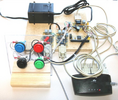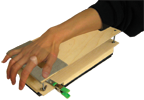








In this paper, we present a methodology for recognizing seatedpostures using data from pressure sensors installed on a chair.Information about seated postures could be used to help avoidadverse effects of sitting for long periods of time or to predictseated activities for a human-computer interface. Our system designdisplays accurate near-real-time classification performance on datafrom subjects on which the posture recognition system was nottrained by using a set of carefully designed, subject-invariantsignal features. By using a near-optimal sensor placement strategy,we keep the number of required sensors low thereby reducing costand computational complexity. We evaluated the performance of ourtechnology using a series of empirical methods including (1)cross-validation (classification accuracy of 87% for ten posturesusing data from 31 sensors), and (2) a physical deployment of oursystem (78% classification accuracy using data from 19sensors).


In this paper we describe Gilded Gait, a system that changes the perceived physical texture of the ground, as felt through the soles of users' feet. Ground texture, in spite of its potential as an effective channel of peripheral information display, has so far been paid little attention in HCI research. The system is designed as a pair of insoles with embedded actuators, and utilizes vibrotactile feedback to simulate the perceptions of a range of different ground textures. The discreet, low-key nature of the interface makes it particularly suited for outdoor use, and its capacity to alter how people experience the built environment may open new possibilities in urban design.








Tactile feedback allows devices to communicate with users when visual and auditory feedback are inappropriate. Unfortunately, current vibrotactile feedback is abstract and not related to the content of the message. This often clash-es with the nature of the message, for example, when sending a comforting message.
We propose addressing this by extending the repertoire of haptic notifications. By moving an actuator perpendicular to the user's skin, our prototype device can tap the user. Moving the actuator parallel to the user's skin induces rub-bing. Unlike traditional vibrotactile feedback, tapping and rubbing convey a distinct emotional message, similar to those induced by human-human touch.
To enable these techniques we built a device we call soundTouch. It translates audio wave files into lateral motion using a voice coil motor found in computer hard drives. SoundTouch can produce motion from below 1Hz to above 10kHz with high precision and fidelity.
We present the results of two exploratory studies. We found that participants were able to distinguish a range of taps and rubs. Our findings also indicate that tapping and rubbing are perceived as being similar to touch interactions exchanged by humans.


Haptic feedback provides an additional interaction channel when auditory and visual feedback may not be appropriate. We present a novel haptic feedback system that changes its elasticity to convey information for eyes-free interaction. SqueezeBlock is an electro-mechanical system that can realize a virtual spring having a programmatically controlled spring constant. It also allows for additional haptic modalities by altering the Hooke's Law linear-elastic force- displacement equation, such as non-linear springs, size changes, and spring length (range of motion) variations. This ability to program arbitrarily spring constants also allows for "click" and button-like feedback. We present several potential applications along with results from a study showing how well participants can distinguish between several levels of stiffness, size, and range of motion. We conclude with implications for interaction design.